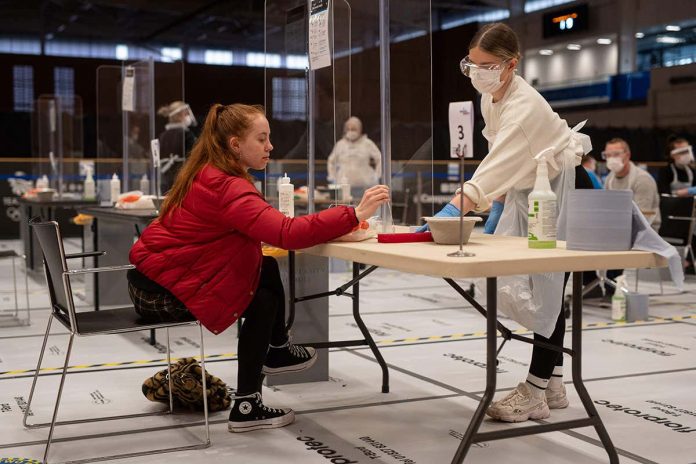
OLI SCARFF/AFP via Getty Images
As the coronavirus pandemic has unfolded this year, many national governments have come under fire for perceived failings in their responses. Yet some organisations took their own steps to combat the virus. New Scientist spoke to some of these universities, companies and sporting bodies to find out how they did it.
Testing methods matter
A coronavirus test isn’t normally the most pleasant of experiences, involving a long swab being put up the nose or to the back of the throat. When students returned to campuses in September, the University of Exeter, UK, encouraged them to come forward for testing if they had covid-19 symptoms by offering saliva tests, which just require spitting into a pot.
When case numbers rose in the region in October, as they did in most of the UK, Public Health England took over testing and switched to the usual swab tests. Once students realised the change of approach, the number of people coming forward for tests dropped, suggesting that the spit method is less off-putting, says Sean Fielding at the University of Exeter. “The numbers of people getting a test went down by half quite quickly when they realised it was a swab test.”
Advertisement
Once the outbreak was brought under control, the university returned to asking for saliva samples.
Screen everyone
The idea of regular frequent tests for all, whether or not they have symptoms, is the basis of the UK government’s shelved “Operation Moonshot”. The problem is that the country doesn’t yet have enough testing capacity to cover everyone.
But some companies are paying private labs to do in-house mass testing of their employees. This is how BAE Systems returned staff to work in September at its shipyard in Barrow-in-Furness, Cumbria, where it makes the Royal Navy’s submarine fleet.
Weekly tests are offered to all 8000 staff members and visitors at the site, using RT-LAMP technology, which gives faster results than the usual polymerase chain reaction (PCR) method – they can arrive as quickly as within an hour. “It’s very fast and very sensitive,” says Chris Stanley at Circular1 Health, which provides the service. Anyone who tests positive is given a second PCR test to confirm the result, which cuts the number of people wrongly told to self-isolate.
Pool testing results
The University of Cambridge has also been offering mass testing for all, but it slashed the number of tests that need to be done by pooling the results from up to 10 people sharing accommodation.
All 15,000 students in college halls or flats are being offered weekly tests. Students in halls are grouped together by those who share kitchens or bathrooms. A pack of swabs is sent to a hall group or household, then students sample themselves and put their swabs into the same pot.
If the liquid from the pot tests positive, each person within that group then takes an individual test. “We are reducing the number of tests by up to seven-fold,” says Patrick Maxwell at the University of Cambridge. Self-sampling also reduces the number of healthcare staff required.
It is impossible to know the strategy’s effectiveness for certain, as it hasn’t been tested in a randomised trial, but the findings posted on the university’s website strongly suggest it is beneficial. The proportion of students at the university who were screened each week had been ramping up since October. By start of December, just over 10,000 individuals were being tested weekly. The prevalence of the virus among asymptomatic students fell from a peak of 1.5 per cent in mid-November to no detectable cases in December, equating to a prevalence of less than 0.01 per cent.
The decline was undoubtedly helped by a lockdown in England for most of November, but figures from the UK’s Office for National Statistics (ONS) suggest that coronavirus prevalence in the community in early December was about 0.9 per cent. The ONS figure isn’t quite a fair comparison as it includes people who have covid-19 symptoms as well as those who are asymptomatic. But one recent report suggests about two-thirds of those who test positive in the ongoing ONS survey are asymptomatic, which would bring the community asymptomatic figure down to 0.6 per cent – still a lot higher than in Cambridge students.
Sewage checks
Testing people’s blood and spit is one way to find carriers of the coronavirus, but there is another fertile testing ground – their faeces. Looking for pathogens in sewage systems can be an efficient way to test many people all at once.
The University of Arizona is carrying out sewage testing at many of its student dormitories and campus buildings, on top of the more usual covid-19 countermeasures. Waste pipes can be accessed either where they exit buildings or through manhole covers.
If a pipe serving multiple buildings gives a positive result, it is hard to act on, says Richard Carmona, a faculty member of the university and a former surgeon general of the US. But when a pipe from a dormitory was positive, every resident was individually tested. Two infected people were found, neither of whom had symptoms. Both then self-isolated. “If we had not picked up those two students the next morning, they would have been spreading it all over the community,” says Carmona. “It gives you an early warning.”
The university is now in talks with architects seeking to design buildings with access to the waste pipes from each floor, letting testers narrow down their search more easily to combat future disease outbreaks.
Bubbling under
As well as the usual testing and contact-tracing measures, some better-funded organisations, such as sports leagues and TV and film companies, have continued through the pandemic by temporarily cutting off employees from the rest of the population, in so-called bubbles. As an outdoor sport that requires little close contact, cricket was an obvious candidate for this approach. Few rule changes were needed, although players could no longer polish the ball with spit or sweat from their face, a common way to make it curve in the air.
The England and Wales Cricket Board (ECB) began a series of international and domestic matches in July for the men’s and women’s sides. In England, games were held at four cricket grounds that had hotels on site. Between games, the players, officials and support staff had to stay in the hotel or its grounds.
Some staff stayed in the hotels for the entire three-month period. Players were allowed to go home between matches, but to re-enter the bubble, they had to be tested for several days beforehand, depending on how risky their home environment was judged to be. “We treated it like a space launch,” says Nick Peirce, chief medical officer for the ECB.
Even when ensconced in the bubble, players took caution in case of false negative test results. They had to wear masks in corridors, stay within certain areas and carry electronic tags to make sure they followed rules and didn’t get too close. “We were always treading a fine line,” says Peirce. “Their behaviour on the field and on the [hotel] balconies was very well observed.”
Although two venue staff did get coronavirus during the summer, they seemed to have caught it from someone outside, with no onward transmission within the bubble. Only one domestic game had to be cancelled, after a player tested positive and it was unclear if he had come into contact with the substitutes. Another player, Jofra Archer, had to isolate in his hotel room for five days after he snuck off between matches to meet a friend at his home.
Yet the strategy was effective overall, says Peirce. TV broadcasters used clever angles to avoid too much footage of the empty stands and added in an artificial background “hum” of a crowd. “Ultimately, the players got to play and people got to watch cricket on TV,” says Peirce. “It was an unbelievable success.”
Sign up to our free Health Check newsletter for a round-up of all the health and fitness news you need to know, every Saturday
More on these topics:











